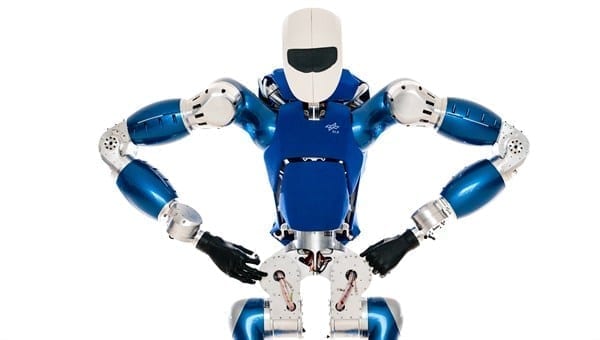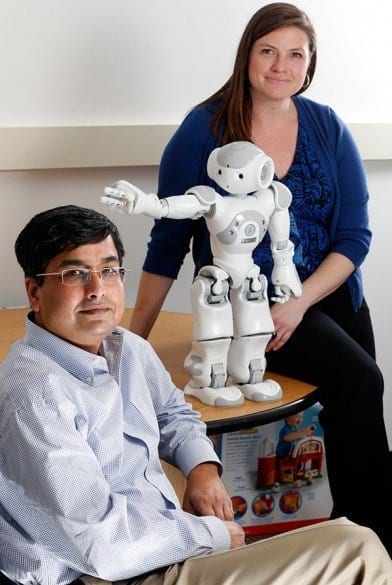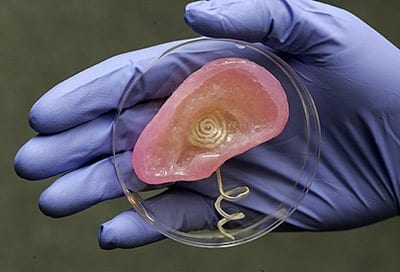
TORO can respond sensitively to its environment
It began in the summer of 2009, with two legs and a camera mounted on top – but it was still far from being a robot of humanoid appearance. Gradually, the TOrque controlled humanoid RObot (TORO), the German Aerospace Center‘s (Deutsches Zentrum für Luft- und Raumfahrt; DLR) walking machine, has become more human-like – an upper body, a head with camera eyes and arms have been added. TORO is now complete, with forearms and hands with sensors and flexible joints that allow it to respond to its environment with exceptional sensitivity. TORO must now learn, step by step, how to perform simple human actions – climbing stairs or opening doors, for example. “Now that the robotic body is complete, we can test processes where the robot carries out sequences of movements with foresight and fluency,” explains Project Manager Christian Ott.
Walking with sentience
Being a walking machine, there is one thing that TORO can, of course, do well – walk. The robot smoothly sets one foot down after the other and moves forwards in small steps. Although the speed is not great, with every step TORO detects the forces at work via sensors in its feet. Torque sensors in the joints ensure that the robot reacts flexibly to its environment. When the walking machine is standing still, it can compensate for impacts against its legs. TORO even manages to do this on a tilt board. “We are working on making it function even better when walking,” says Ott. TORO does this with remarkably small feet. This is a difficult obstacle that the scientists have chosen for themselves. “On the one hand, we wanted to make it more difficult by using a small footprint, but on the other, it enables the robot to climb over obstacles more easily.” The inclusion of an upper body and arms has added another challenge.
Experimenting on two legs
For the researchers, the walking machine is not merely a robot that is expected to learn and master specific tasks; it is a testing ground for all the technology required. While other robots are primarily expected to move around a known environment in a programmed way, researchers want TORO to develop other talents. Above all, they expect to prove its ability to operate independently, flexibly and safely in a new, unknown environment. To do this, the researchers at the DLR Institute of Robotics and Mechatronics are drawing on knowledge they already have; TORO’s arms and legs are based on DLR’s lightweight robots, which are already being used in car manufacturing. These, too, are fitted with sensors and react flexibly to any external disturbances. The researchers chose particularly powerful motors for the walking machine’s legs. The motors for the arms needed to be somewhat less powerful. In terms of TORO’s appearance, this means powerful legs and thinner arms.
Human intuition
With its arms and hands, TORO will now move on to the next phase of development, in which the interaction with the environment will be even greater.
The Latest Bing News on:
TORO robot
- Best deals on robot vacuums ahead of Memorial Dayon April 25, 2024 at 10:18 am
Promotions are subject to availability and retailer terms. The only catch? Robot vacuums are pricey. The best way to cut down on the expense is to buy one ahead of Memorial Day. Knowing that robot ...
- DreamWorks Will Preview ‘The Wild Robot’ at Annecy Animation Festivalon April 24, 2024 at 1:25 pm
DreamWorks Animation will showcase a sneak peek of “The Wild Robot” at the Annecy Animation Festival (June 9-15). The preview footage will take place June 11, hosted by writer/director Chris Sanders ...
- ‘Robot Dreams’ Trailer: Pablo Berger’s Oscar-Nominated Animated Debut Hits Theaterson April 23, 2024 at 11:30 am
The Oscar-nominated feature premiered at the 2023 Cannes Film Festival and later won the Special Jury Prize at the Animation Is Film Festival. “Robot Dreams” marks the “Blancanieves” filmmaker ...
- The 6 best robot lawn mowers in 2024 are here to make your Roomba jealouson April 18, 2024 at 3:46 pm
Hate mowing your lawn? Well now you can let a robot do it for you. Check out these latest robotic lawn mowers.
- How Home Robots Will Change The Technology Industryon April 18, 2024 at 6:30 am
Out of all the predictions I made, the one that surprised people the most was my prediction that we will start seeing the wider adoption of home and office robots. In this article, I want to ...
- Review: Latest Landroid robo-mower could do with a tad more Visionon April 16, 2024 at 3:06 am
We've now spent several months with the latest wire-free Landroid robo-mower, and we've found it a mix of confusing, educational, satisfying and highly entertaining. Oddly enough, the one thing the ...
- The cheapest robot vacuum sales and deals for April 2024on April 8, 2024 at 5:00 pm
Cheap robot vacuum sales are getting easier to find. With more models hitting the shelves at a budget-friendly price point (and those devices seeing regular discounts on top), there's some ...
- Why Pacific Rim Terrified Director Guillermo Del Toro Like Never Beforeon April 6, 2024 at 5:07 pm
when del Toro was "struck by a sudden attack of nerves," which was new for the director. After all, the Comic-Con contingent is typically fans of his work, and a big movie about giant robots ...
- Here’s What Hyundai’s Delivery Robot Is Really Foron April 5, 2024 at 9:14 am
Hyundai and Kia reveal DAL-e delivery robot, meant for indoor settings, featuring a cargo capacity of 22 pounds. The robot can autonomously navigate complex environments, and use facial ...
- Robot vacuum buying guide—what you need to knowon April 4, 2024 at 12:38 pm
Robot vacuums have come a long way since they first appeared over 20 years ago. Initially viewed more as a novelty, these robots have only become a household staple appliance in recent years.
The Latest Google Headlines on:
TORO robot
[google_news title=”” keyword=”TORO robot” num_posts=”10″ blurb_length=”0″ show_thumb=”left”]
The Latest Bing News on:
Humanoid robot
- Top US-based humanoid robotics firm pivots to China-dominated all-electric tech raceon April 28, 2024 at 4:00 am
One of the world’s top robotics companies has announced it will stop developing hydraulic-powered humanoid robots and instead focus on making electric motor-driven robots – a category that Chinese ...
- China unveils “Tiangong”: First fully electric humanoid robot capable of running at 6 km/hon April 27, 2024 at 5:10 am
China's Beijing Humanoid Robot Innovation Center unveils "Tiangong," a robot capable of human-like running at 6 km/h.
- Astribot S1 AI Humanoid robot unveiled demonstrating its agility, dexterity and accuracyon April 27, 2024 at 12:55 am
This week the Astribot S1 humanoid robot was unveiled in Shenzhen, China, marking another significant leap forward in autonomous robotics ...
- China’s S1 robot impresses with its ‘human-like’ speed and precisionon April 26, 2024 at 8:34 am
In a video released by the firm, its humanoid S1 is seen doing household tasks at an unprecedented pace, which marks a significant advancement for a robot. The firm claims that S1 can perform ...
- Elon Musk Says Tesla’s Humanoid Optimus Robot Could Launch Next Year—Here's What Experts Thinkon April 26, 2024 at 7:58 am
The robots will not come close to bringing in the kind of money Tesla’s cars do, and experts said it’s a long shot as to whether Musk could meaningfully launch Optimus by the end of 2025.
- World's fastest humanoid robot unveiled – but there's something odd about how it runson April 26, 2024 at 7:00 am
A Chinese firm has created the world’s fastest humanoid robot – but don’t worry, you can probably still outrun it. For now. Clocking in at seven miles per hour, an impressive speed for today’s robots, ...
- Video of super-fast, super-smooth humanoid robot will drop your jawon April 26, 2024 at 3:51 am
While it seems that another humanoid robot is being released every week, we've yet to see one move as quickly or with as much precision as the model just released by Chinese company, Astribot. We dare ...
- Robot Speaker at Commencement? Some Human Students Balkon April 26, 2024 at 12:48 am
Enter Sophia, a humanoid robot first launched in 2016 from Houston-based Hansen Robotics. The Buffalo university announced Wednesday it would bring Sophia to speak at its May 11 commencement ceremony.
- Sanctuary’s new humanoid robot learns faster and costs lesson April 25, 2024 at 12:41 pm
Sanctuary AI often isn’t mentioned in the same breath as humanoid robotics firms like Boston Dynamics, Agility, Figure and 1X, but the Canadian company has been operating in the space for some time.
- Top 6 Humanoid Robot Companies To Consider As A New Trend Potentially Takes Offon April 22, 2024 at 8:37 am
Discover the booming global market for humanoid robots set to reach $38 billion by 2035. Click for a full review of current humanoid robotics firm developments.
The Latest Google Headlines on:
Humanoid robot
[google_news title=”” keyword=”humanoid robot” num_posts=”10″ blurb_length=”0″ show_thumb=”left”]











